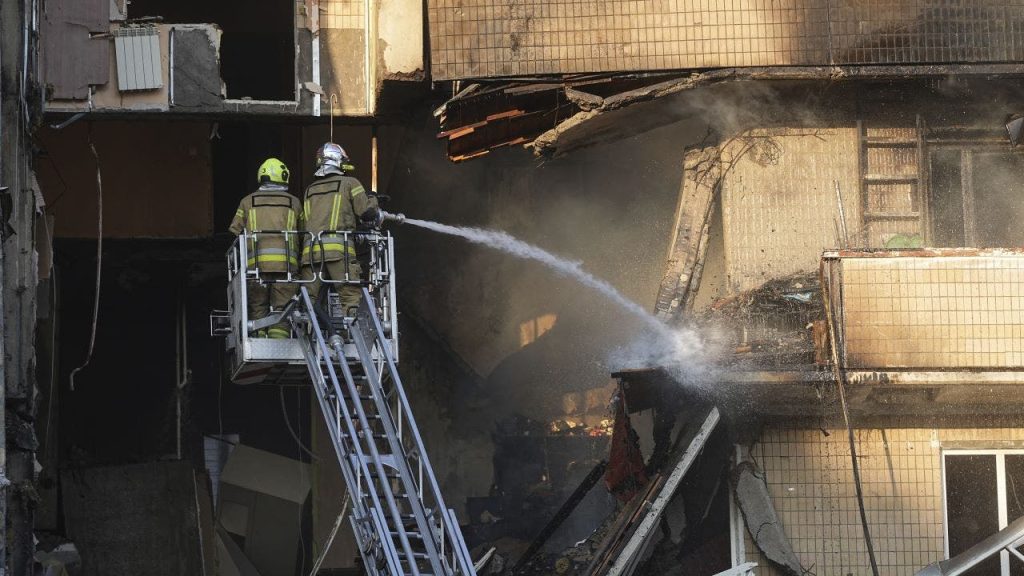Russia Launches Unprecedented Air Attack on Ukraine
In a devastating escalation of the ongoing conflict, Russia unleashed its largest air assault on Ukraine since the war began. On Sunday, Ukrainian skies were filled with an unprecedented barrage of drones, decoys, and missiles, striking civilian and government structures alike. The attack represents a significant intensification of Russian aggression, pushing the boundaries of previous military actions by directly targeting government facilities in Kyiv, something that had been largely avoided until now. This massive aerial assault has left Ukrainians reeling, dealing with both the physical destruction and the psychological impact of such a coordinated strike against their nation.
Ukrainian defense forces demonstrated remarkable effectiveness despite the overwhelming nature of the attack. According to Ukraine’s air force, they successfully intercepted 747 of the 810 drones and decoys deployed by Russian forces, along with four of at least 13 missiles. This extraordinary defensive effort highlights the growing capabilities of Ukraine’s air defense systems, which have been bolstered by Western support throughout the conflict. However, even with this impressive interception rate, the sheer volume of the attack meant that significant damage was inevitable. Confirmed hits from nine missiles and 54 drones were recorded across 33 locations throughout Ukraine, with debris from intercepted projectiles causing additional damage in eight locations. The scale of this assault suggests a troubling new phase in Russia’s military strategy, one that appears designed to overwhelm Ukrainian defenses through sheer numbers.
The human toll of this massive attack continues to emerge, with at least two people confirmed dead and twenty injured in Kyiv alone. These numbers represent real people whose lives have been tragically altered in an instant – families torn apart, communities shattered, and countless individuals left to deal with physical and emotional wounds. Perhaps most symbolically significant was the strike on Ukraine’s Cabinet of Ministers building, which houses the offices of government officials who have been coordinating the country’s resistance and recovery efforts. Images from Kyiv showed significant damage to this government facility as well as to residential buildings, emphasizing Russia’s apparent willingness to target both governmental infrastructure and civilian areas. The attack on the Cabinet building marks a concerning escalation, potentially signaling Russia’s intent to directly disrupt Ukraine’s governance capabilities.
Ukrainian Prime Minister Yulia Svyrydenko’s response captured both the resilience and the heartbreak felt across the nation. “For the first time, the government building was damaged by an enemy attack, including the roof and upper floors,” she stated. “We will restore the buildings, but lost lives cannot be returned.” Her words reflect the grim reality facing Ukrainians – while physical structures can be rebuilt, the human cost of this conflict remains irreplaceable. Svyrydenko called for more than just expressions of sympathy from the international community, urging concrete action through increased sanctions pressure against Russian oil and gas exports. Her plea highlights the frustration many Ukrainians feel regarding the continued flow of European funds into Russia’s economy through energy purchases, effectively financing the very weapons being used against them.
This latest attack comes amid complex international dynamics surrounding the conflict. Former President Donald Trump recently urged European leaders to cease purchasing Russian oil, pointing to these energy transactions as a critical funding source for Russia’s war machine. While the European Union has significantly reduced its Russian oil imports following the invasion, it has not completely severed energy ties with Moscow. This partial approach has allowed Russia to maintain substantial revenue streams despite international sanctions, underscoring the challenges of implementing truly effective economic pressure. The timing of this massive attack also raises questions about Russia’s strategic intentions, as it occurred against the backdrop of Russian President Vladimir Putin extending an invitation to Ukrainian President Volodymyr Zelenskyy for security talks in Moscow – an offer that seems deeply contradictory given the simultaneous bombing campaign.
As Ukraine works to recover from this unprecedented assault, the international community faces renewed pressure to respond more decisively. The scale and nature of this attack – particularly the targeting of government buildings in Kyiv – represents a significant escalation that demands more than routine condemnations. Ukrainian officials continue to emphasize that rebuilding physical structures, while challenging, remains possible; it is the loss of human life and the ongoing psychological trauma inflicted on civilians that constitutes the true tragedy of this conflict. As emergency services work through the aftermath and as more comprehensive casualty reports emerge, the world watches to see whether this attack will mark a turning point in international support for Ukraine or whether it will become simply another tragic milestone in a war that continues to redefine the boundaries of modern European conflict.


